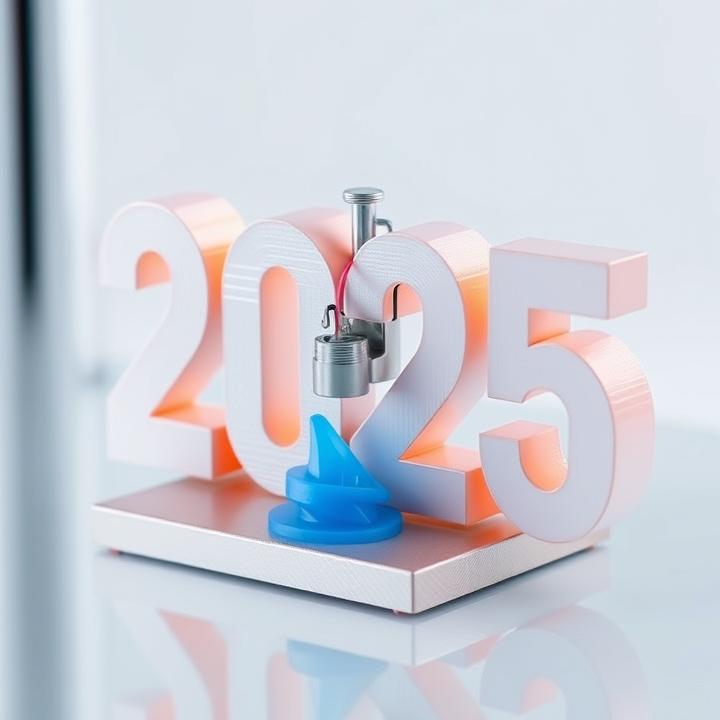Exploring the Future of 3D Printing in 2025: Key Innovations, Industry Applications, and Growth Opportunities

The world of 3D printing is evolving rapidly, introducing groundbreaking innovations and expanding its applications across diverse industries. This article delves into upcoming trends, such as bioprinting advancements, sustainable materials, and AI-driven design automation.
Discover how 3D printing technology will shape various sectors, from healthcare to construction, in 2025 and beyond. Additionally, understand the challenges, ethical considerations, and regulatory factors that businesses should anticipate to fully adapt to this rapidly evolving technology.
3D printing, also known as additive manufacturing, has rapidly advanced from a niche technology used primarily for rapid prototyping into a game-changing solution across various industries. Over the past decade, 3D printing has enabled more efficient production methods, more complex designs, and unprecedented customization. From healthcare to aerospace and automotive manufacturing, industries are increasingly adopting 3D printing not only to cut costs but to create parts and products that were once impossible to achieve with traditional manufacturing techniques.
Looking ahead to 2025, 3D printing is expected to take center stage as one of the key technologies shaping our future. Advances in material science, artificial intelligence (AI), and bioprinting are leading the way, opening up new possibilities for innovation. However, these advancements bring challenges related to regulation, ethics, and sustainability. In this article, we will take a deep dive into these trends, examining the innovations that are likely to define the future of 3D printing in 2025.
Key Innovations in 3D Printing Technology
The 3D printing landscape is continuously evolving, driven by several key innovations that will shape the industry’s future. These developments promise to unlock new potential across all areas of manufacturing, healthcare, and beyond.
Artificial Intelligence and Automation in 3D Design
The integration of artificial intelligence (AI) and automation is one of the most transformative advancements in 3D printing technology. In the past, 3D printing required manual design and setup, which was often time-consuming and error-prone. However, AI has now enabled the creation of smarter 3D design tools. These AI-driven systems use machine learning algorithms to predict and optimize design elements based on data collected from previous prints.
One of the key benefits of AI in 3D printing is generative design. Generative design software uses AI algorithms to explore all possible design permutations based on input constraints (e.g., material type, strength, weight). Designers can input basic parameters and allow the software to generate multiple design solutions that are optimized for the intended purpose. This approach leads to more efficient designs that are often lighter, stronger, and more resource-efficient than those made using traditional methods.
Additionally, AI enables automation throughout the 3D printing process, enhancing production efficiency. For example, AI tools can monitor print quality in real-time, automatically adjusting parameters to compensate for environmental factors like humidity or temperature changes, which might otherwise affect print quality. This automation ensures more accurate and consistent prints, which is especially crucial for industries such as aerospace and medical devices, where precision is paramount.
Multi-Material and Multi-Color Printing
Historically, 3D printing was limited to printing with a single material at a time. However, recent innovations in multi-material printing have revolutionized the industry. Multi-material printers allow for the use of different materials in a single print, opening up new possibilities for creating complex, functional prototypes and products.
For example, in industries like automotive and aerospace, multi-material printing is used to combine different types of plastics, metals, and composites within the same part, achieving unique properties such as enhanced strength, flexibility, or resistance to high temperatures. In consumer products, multi-color printing enables the creation of visually striking designs, such as prototypes of electronic gadgets with integrated colors, textures, and patterns.
Moreover, combining different materials during the printing process also offers significant time and cost savings by eliminating the need to print components separately and assemble them manually. Multi-material printing has profound implications for industries like fashion and healthcare. In fashion, designers are creating intricate, multi-textured garments and accessories using 3D printing, while in healthcare, personalized prosthetics and implants can be made from multiple materials that mimic the natural flexibility and structure of human tissue.
Bioprinting and Tissue Engineering
One of the most exciting areas in 3D printing is bioprinting, where living cells are used as a printing material to build tissues and organs. Bioprinting has the potential to revolutionize medicine by creating tissues for drug testing, organ replacement, and regenerative therapies. Over the past few years, researchers have made significant strides in improving bioprinting technologies, leading to more complex and functional printed tissues.
Currently, bioprinting is mainly used to create 3D models of human tissue, such as skin, cartilage, and bone, to study diseases and test new drugs. However, advancements in this field are bringing us closer to the dream of creating fully functional organs. In the near future, it may be possible to print organs such as kidneys, hearts, and livers, offering a potential solution to the global organ shortage crisis.
One of the challenges in bioprinting is ensuring the survival and functionality of cells once they have been printed. Researchers are working on developing bio-inks made from living cells, which allow printed tissues to grow and mature, potentially leading to the creation of tissues that can be used for transplants. This area of 3D printing holds enormous promise for the healthcare sector, but ethical, regulatory, and technical challenges remain, such as how to safely implant these printed organs into the human body.
Applications Across Industries
The impact of 3D printing extends far beyond prototyping. It is now being embraced across multiple industries, enabling new manufacturing methods, reducing waste, and providing better, more customized products.
3D Printing in Healthcare and Medicine
3D printing has already made significant inroads into healthcare, and its potential continues to expand. Customization is one of the most valuable aspects of 3D printing in healthcare, allowing medical devices, prosthetics, and implants to be made specifically for individual patients. Traditionally, creating custom prosthetics was a lengthy and costly process, but with 3D printing, medical professionals can create tailored solutions more quickly and affordably.
3D-printed prosthetics are often more comfortable than traditional ones, as they can be designed to fit a patient’s body precisely. This is especially important in areas like orthopedics, where the customization of implants can lead to better patient outcomes and reduced recovery times. Similarly, 3D-printed surgical guides are becoming more common, as they help surgeons plan and rehearse complicated procedures using patient-specific anatomical models.
Beyond prosthetics, 3D printing is being used in drug development and production. Pharmaceutical companies are using 3D printers to produce personalized medications, where doses can be tailored to the specific needs of an individual. Moreover, 3D printing of medical devices allows for rapid prototyping, enabling faster testing and iteration of new tools, improving the speed at which medical innovations reach patients.
Automotive and Aerospace Industry Adoption
The automotive and aerospace industries are two of the most prominent adopters of 3D printing technology. In both industries, the focus has been on reducing weight, increasing fuel efficiency, and enabling faster prototyping and production cycles.
In the automotive industry, 3D printing is increasingly used for rapid prototyping, which allows manufacturers to quickly iterate on designs and make adjustments before moving to full-scale production. For example, Ford has used 3D printing to produce prototype parts for its vehicles, enabling the company to test new designs and manufacturing processes without the need for traditional tooling.
Similarly, the aerospace industry has embraced 3D printing for the production of lightweight, high-strength components. For instance, General Electric uses 3D printing to manufacture parts for its jet engines, such as fuel nozzles, which are produced with complex geometries that reduce the part’s weight while maintaining durability. These innovations not only save weight but also help reduce material waste and lower production costs.
As 3D printing technologies continue to evolve, these industries will likely see further integration of additive manufacturing into their production processes, particularly as new materials and more efficient printers become available.
Construction and Architecture
The construction industry is gradually adopting 3D printing for the creation of entire buildings and infrastructure components. In fact, several companies have already demonstrated the feasibility of 3D-printing homes. This process allows for the printing of walls, floors, and even entire structures with minimal human labor involved.
3D printing in construction has numerous benefits, such as reduced waste and energy consumption. Traditional construction methods often lead to significant material waste, but 3D printing enables precise control over material usage, minimizing excess. In addition, because 3D printing can use a variety of sustainable materials, it holds the potential to reduce the environmental impact of construction projects.
One of the most exciting applications of 3D printing in construction is the ability to create highly customized and unique architectural designs. With traditional methods, creating intricate, custom details is often time-consuming and expensive, but with 3D printing, these complexities can be achieved with ease. This has opened up possibilities for more creative, sustainable, and functional buildings, particularly in areas where traditional construction methods are difficult or costly to implement.
Challenges and Regulatory Considerations
Despite the many benefits of 3D printing, there are still challenges that need to be addressed to ensure its widespread adoption. From ethical concerns to regulatory obstacles, these challenges must be navigated carefully as the technology continues to evolve.
Ethical Concerns and Bioprinting
As 3D printing technology progresses, it raises important ethical considerations, particularly in the area of bioprinting. The idea of printing human tissues and organs raises questions about the limits of technology and the potential consequences of its misuse. For example, if bioprinting leads to the creation of fully functional organs, how should these organs be distributed? Should there be limits on who can access bioprinted tissues or organs, and how should such decisions be made?
Moreover, the use of genetic editing in bioprinting could lead to unforeseen consequences. While genetic engineering may hold the key to developing organs with fewer rejection risks, it also opens the door to “designer” genetic modifications. These advancements will require careful ethical oversight to prevent misuse, such as eugenics.
Intellectual property concerns also come to the forefront with 3D printing. As the ease of replication increases, so too does the risk of intellectual property theft. Companies that rely on proprietary designs for their products must ensure that their intellectual property is well-protected in the face of this rapidly evolving technology.
Regulatory Challenges
Regulation has not kept pace with the rapid growth of 3D printing, leaving many industries uncertain about how to proceed. In healthcare, for example, the FDA and other regulatory bodies must develop new frameworks for assessing the safety of bioprinted tissues and organs. These products will need to meet stringent quality and safety standards, but current regulations may not address the unique challenges posed by 3D-printed medical devices and tissues.
In other industries, such as construction, there is also a lack of clear regulatory guidelines. Local building codes were not designed with 3D printing in mind, so lawmakers will need to create new standards to govern the use of this technology in construction projects. Without clear regulations, companies could face delays or legal challenges as they attempt to implement 3D printing in their operations.
Environmental Impact and Sustainability
While 3D printing offers a range of environmental benefits, such as reducing material waste and enabling more sustainable production methods, it also introduces new concerns. The environmental impact of 3D printing depends largely on the materials used in the process. Some commonly used materials, like certain plastics, can take centuries to decompose, leading to concerns about waste accumulation if not properly managed.
As the industry grows, there is increasing pressure to develop more sustainable materials and practices. For example, bio-based plastics and recycled materials are being explored to reduce the environmental impact of 3D printing. Additionally, energy consumption remains a concern, particularly with large-scale 3D printers used in industrial applications. Energy-efficient printing processes and machines will be essential to minimizing the carbon footprint of additive manufacturing.
The Future Outlook for 2025 and Beyond
As we look to 2025, 3D printing is poised to play a major role in the future of manufacturing, healthcare, and construction. The innovations discussed in this article, such as AI-driven design, bioprinting, and multi-material printing, will shape industries in ways that we are just beginning to understand.
The challenges facing 3D printing, including regulatory hurdles and environmental concerns, will require ongoing attention. However, the continued development of new materials, more efficient printing processes, and better integration with AI and automation will overcome many of these obstacles, allowing 3D printing to become an even more integral part of the global economy.
By 2025, industries will have fully integrated 3D printing into their design and production processes, making it a cornerstone of modern manufacturing. Those who are able to adapt to these changes will be best positioned to thrive in the increasingly competitive and technology-driven marketplace.
The future of 3D printing is bright, with transformative potential across multiple industries. From personalized medical devices to custom-designed homes, the technology is pushing the boundaries of what’s possible in manufacturing and production. While challenges remain, such as regulatory compliance and sustainability, the rapid pace of innovation in 3D printing will continue to drive change in the years to come. As we approach 2025, staying informed about the latest advancements and understanding their implications will be essential for businesses and consumers alike to harness the full potential of this remarkable technology.





